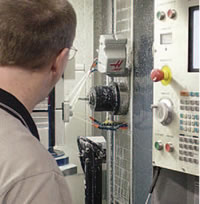
To begin the discussion we must define the types of coolants available. Most coolant manufacturers offer three types of fluids, each having their own positive and negative attributes.
Emulsified oil (sometimes called soluble oil), semi-synthetic, and synthetic coolants are the three most common alternatives. All of these alternatives require additional components for improved machining as well as foam control, biological control, pH stability and corrosion control. Occasionally, other additives will be used to reduce staining of sensitive metals and lesson degradation of carbide. In order to properly manage your coolants, understanding that additives are often used up at different rates is extremely important. This process is called selective depletion. One of the most common examples of selective depletion can be seen when corrosion prevention additives are depleted in cast iron applications before Steel alloy applications.
Soluble Oils — These types are very common and generally form a milky, opaque fluid. Typically soluble oils are 50% oil, or more, and balanced by emulsifier and additives. Most heavy duty soluble oils have added chlorine to enhance extreme pressure machining.
Oil provides lubricity for much of the machining as well as excellent corrosion control for the machine and its parts. Unfortunately, oil emulsifiers are known as a favorite food source for bacteria, and often impede the heat dissipation process.
Semi-Synthetics — This type of coolant contains both oil and a synthetic (polymer). A semi-synthetic coolant can contain anywhere from 5% oil to 35% oil. The smaller percentage of oil in semi-synthetics allows for heat to be dissipated much faster than with soluble oils, improving tool life and finish. Much like soluble oils, chlorine is sometimes added to improve heavy machining performance.
Synthetic — Synthetics often contain as many as 17 ingredients, including polymers, which are used to replace the oil and cutting additives found in soluble oils and semi-synthetics. Without oil, additives are required to control corrosion. The historic problems of corrosion control and hard deposits on the machine tool have improved with the development of modern coolants. Some modern formulas actually emulsify a limited amount of oil to help improve performance. Without oil however, synthetic coolants can offer superior cooling with extended tool and sump life.
Ask the Experts — As you decide which type of coolant to use, discuss these issues with your coolant vendor. Factors such as tooling, machine type, age of the machine tool, metals machined, maintenance and operator exposure need to be considered before a selection can be made.
Coolant Management — If you decide not to control your coolant, the soluble oils are generally the most forgiving. If you take some care with your coolants and monitor the concentration, a semi-synthetic can be very effective. If you have a coolant management program in place, you can reap the benefits of synthetic coolants with little trouble.
Costs — In short, coolant costs will vary. Discrepancies in coolant costs are directly related to the amount and the quality of the additives they incorporate into their formula. Coolant manufacturers can easily control the cost of their product by simply adding or reducing additive levels. As an example, coolants using the same biocide can vary their concentration from 1% to 3.5%. A basic biocide can cost around $2.00 per pound, while a combination bacteriacide/fungicide can cost over $4.00 per pound. You do get what you pay for.
With the cost of oil and other oil derivatives on the rise, coolant costs are sure to follow. Now more than ever, the importance of maintaining your coolant to maximize its useful life should not be understated. However, it is important to note that your coolant management program will only be as successful as the quality of the coolant you choose.
|
ETNA Products 16824 Park Circle Drive, Chagrin Falls, Ohio 44023 Phone: 800-229-3862 / 440-543-9845 Fax: 440-543-1789 Copyright ©2026 ETNA Products, Inc. KOOLRite and SynMAX are trademarks of ETNA Products, Inc. |